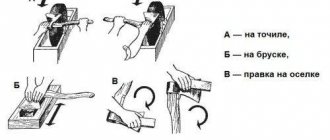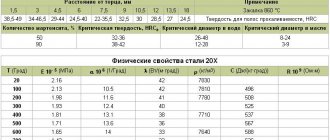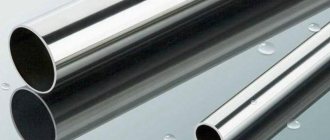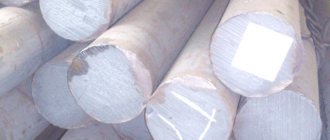Features of cold rolled sheet
General purpose cold-rolled sheet is made from the following grades of steel: 08kp, 08ps, 10kp, 10ps, 15kp, 15ps, 20kp, 20ps, 25, 30, 35, 40, 45. The chemical composition of steels is determined by GOST 1050-88.
High quality cold steel sheet for cold stamping is made from steels: 08Yu, 08ps, 08kp.
Cold rolled steel has a smoother surface and more precise right angles.
Cold-rolled sheet, contrary to its name, does not escape heat treatment: any cold-rolled sheet is made from a hot-rolled billet. Sheet steel in coils made by hot-rolling is subjected to additional processing to remove scale - pickling. Only after this procedure are the sheets subjected to cold rolling, sometimes with compression.
Differences in production technology
The first thing that distinguishes hot-rolled sheets from cold-rolled sheets is the production technology. Please note the following points:
- Hot rolling involves a high thermal effect on the workpiece, which gives it increased ductility. As a result, it is possible to simplify the technological process and reduce its cost. But with this approach it is difficult to achieve uniform thickness, especially with small values.
- Cold rolling does not involve heating the source material. But later the sheet is subjected to etching, shot blasting, hardening and so-called tempering, which makes it possible to further improve the surface quality and increase the strength characteristics of the material.
The production technology itself determines the performance characteristics of cold-rolled and hot-rolled sheets.
Features of hot rolled sheet
The material for the steel sheet can be carbon steel, structural steel or alloy steel.
Carbon steel (ordinary quality and high-quality) for the production of rolled sheets must correspond to strength groups OK300V, OK360V, OK370V, OK400V. Each strength group has its own steel grades.
Typically, hot-rolled products have a scaled surface and rounder, less precise corners than cold-rolled products.
The hot rolling process takes place at temperatures in excess of 1,700 degrees Fahrenheit. Thanks to this metal it is much easier to give the desired shape. In addition, large steel sheets can be used as a workpiece. Hot rolling is usually cheaper than cold rolling, and the process itself often occurs without pauses, so the metal does not have to be heated. However, during cooling, hot-rolled steel contracts, making it more difficult to predict the size and shape of the finished product than with cold-rolled steel.
What is the result?
When hot-rolled, the sheet becomes less even, and harmful scales form on the surface. There will be no such disadvantages on a cold-rolled sheet, but it will be more expensive.
In order to make the right choice, you should start from the area of use of sheet metal. If such shortcomings as scale or imperfect sheet surface do not greatly affect the properties of the future product, then you should choose hot-rolled sheets; in terms of durability and reliability, they are not comparable to cold-rolled ones.
You can purchase high-quality galvanized sheets from us at an attractive price, call and order today!
Differences between hot-rolled and cold-rolled sheets
- Thickness. Cold rolled sheets are always thinner. The thickness of hot-rolled ones reaches 200 mm, cold-rolled ones – 5 mm;
- The manufacturing accuracy of cold-rolled sheets is higher;
- Cold rolled sheet has a hardened surface layer.
| Cold rolled sheet | Hot rolled sheet | |
| Surface | It has a smooth surface, therefore it is used in those areas where an aesthetically smooth surface is required in the final product, in particular, in the production of products and in instrument making. | The surface is uneven, most often the middle of the sheet “sinks”, therefore it is mainly used in construction and when welding metal structures. |
| Sheet stress | It is distributed evenly and “leads” less when welding. This is an important property of metal for any field, but especially in instrument making and automotive manufacturing. | It is distributed unevenly, which is why the material may “lead” during welding. Despite this quality, it is also used in automobiles, shipbuilding and even aircraft construction. |
| Material of manufacture | It is usually made of low-carbon steel and has high ductility (that is, it can be bent repeatedly and strongly), so it is mainly used for stamping. | Made from carbon, low-alloy steel. Alloy steel is also used in the manufacture of boilers and pressure vessels. |
| Areas of application |
|
For welded and bolted structures; |
How is cold-rolled sheet made and where is it used?
Cold rolled products are produced from hot-rolled steel. The workpieces are first pickled in a bath of sulfuric acid solution to remove the scale. The material is cut to the required width and oiled. After which it is sent to the mill, where it is compressed with rollers to obtain the desired thickness. The structure of steel is improved by heat treatment - fired in bell furnaces at temperatures up to 730 °C. After cooling, the workpiece shrinks by up to 3% to increase strength. Further, the sheets, depending on the purposes of further use, can be subjected to various processes that improve the mechanical characteristics of the material and surface properties.
Such metal products are mainly used for parts with precise physical and mechanical characteristics:
— in the aerospace industry; — in machine tool and electrical engineering industries; - in construction.
Properties of cold rolled steel
The basis for the production of cold-rolled sheets is hot-rolled sheets. They undergo additional processing to improve their characteristics:
- make edges, dimensions, thickness clearer;
- get rid of impurities - scale;
- give the surface smoothness, uniform color, and a characteristic metallic sheen;
- add rigidity to the material.
Unlike hot-rolled steel sheet, cold-rolled metal is thinner: thickness varies from 0.35 mm to 5 mm.
This material requires additional anti-corrosion treatment. It is usually coated with zinc, chrome, aluminum or other elements to prevent accelerated rusting.
Assortment of cold-rolled sheets according to GOST
Cold-rolled sheets are standardized by GOST numbers:
- 9045-93 - rolled products for cold stamping or production of car bodies. Upon request, the surface receives an increased, high or especially high category.
- 16523-97 - standards for cold-rolled sheets made of black carbon steel. The standard describes three types of surface finishing.
- 19904-90 - production of rolled products with a thickness of 0.35-5 mm. The document specifies the width of the rolled products produced in the form of cards equal to 500-2350 mm, and the length - 1-6 m. The dimensions of the rolls are not limited, only the thickness is standardized - up to 3.5 mm.
Advantages and disadvantages
Advantages of the cold rolled method:
| Disadvantages of the cold rolled method:
|
This leads to the fact that the choice between cold-rolled sheet and hot-rolled sheet is determined by the area of application of the metal products.
Features of choice
Before you start seriously selecting specific hot rolled sheets, here are a few helpful tips:
- Strictly and irrevocably establish the purpose of your sheets. Buying material just like that, in the hope that you will later find a use for it, is very stupid and reckless.
- Don't save money. Yes, construction and repairs are extremely expensive, but you definitely shouldn’t skimp on such large-scale materials. This may affect the safety and durability of the final structure.
What are the differences between the applications of cold-rolled sheets and hot-rolled sheets?
The difference in properties determines different areas of use.
Hot rolled sheet is most often used:
- in construction - for the manufacture of load-bearing coatings;
- in shipbuilding, aircraft and mechanical engineering;
- for creating structures using welded, bolted, riveted joints;
- for the production of welded pipes.
Application areas of cold rolled sheets:
- production of corrugated sheets, smooth galvanized sheets;
- automotive industry;
- obtaining tin - a thin sheet or strip with a protective, most often tin, coating, used for the manufacture of cans;
- etched annealed sheet - decapir - is used for the manufacture of enamel dishes.
What is the key advantage of cold rolled steel?
Cold rolled steel is produced on cold reduction machines, where the material is cooled to near room temperature, followed by annealing and/or skin pass rolling. This process produces steel with a wide range of surface finishes and superior tolerances, concentricity and straightness compared to hot rolled steel. Cold rolled steel contains low carbon content and the annealing method makes it softer than hot rolled steel. Cold rolled steel products are typically produced in sheets, strips, rods and rods. Cold rolled products are typically smaller than the same product produced by the hot rolled process.
Cold rolled steel sheets and strips are available in semi-hard, semi-hard, quarter-hard and tempered grades. Among these conditions, rolling with full hardness reduces the thickness by almost 50%, while other conditions are thicker. Rolled steel billet is commonly used in subsequent cold working methods where good ductility is required.
Other shapes can be cold rolled if the cross-section is relatively uniform and the cross-section is relatively small. Cold rolled profiles are processed in a series of forming operations. This is typically done along the sizing, staking, roughing, semi-finishing, semi-finishing and finishing lines.
Cold rolled steel is used to produce a variety of products, from household appliances such as refrigerators and washing machines, to industrial equipment, architectural components, automobiles and various construction-related products. Cold rolled steel is an indispensable material in modern society. Cold rolled steel has anti-corrosion properties. A smoother surface is more resistant to corrosion.
You can buy cold-rolled metal products on our metal warehouse website through the product catalog. We offer only high-quality cold-rolled metal from the best manufacturers in Russia with free delivery within the Ring Road.
The nuances of making cold-rolled steel
Hot-rolled and cold-rolled steel differ in heating conditions. Cold-rolled steel is steel that undergoes compressive deformation when passing through rolling rolls without preheating. The cold-rolled sheet is obtained from the corresponding hot-rolled bar, which has previously undergone surface cleaning. The geometry of rolled products at the end of the production process must also comply with the requirements of regulatory and technical documents, such as DSTU 8971, GOST 19904, DSTU EN 10131. The process of manufacturing cold-rolled rolls has the following features:
- First, the hot-rolled semi-finished product is cleaned of the oxide layer and contaminants by etching in acids and/or with metal shot supplied by compressed air.
- the prepared product is fed to a cold rolling mill (CRM), where it is subjected to plastic deformation until the required geometry is obtained (usually cold-rolled steel is produced no thicker than 5 mm);
- After rolling, heat treatment is performed to impart the required set of properties to the product and eliminate structural heterogeneity. Most often, annealing (temperatures above 900°C) is used as a heat treatment for cold-rolled coils - the alloy recrystallizes, its plastic properties increase;
- Tempering is an optional step after heat treatment, which involves another cold rolling with minimal reduction to improve the surface quality of the coils.
Properties of hot rolled steel
Hot rolled sheets have a rough surface. The finished sheet has rounded, imprecise corners. If they are trimmed, the material is marked with the index O; if it is supplied without trimming, it receives the index HO. The thickness of this type of steel is uneven and is characterized by a high percentage of scale content.
Assortment of hot-smoked sheets according to GOST
Accepted standards divide hot-rolled sheet metal into types according to thickness and area of use. Currently there are GOST standards with numbers:
- 14637-89, which describes the parameters of hot-rolled thick sheets with a thickness of 4-160 mm of normal quality, produced from carbon steels;
- 16523-97, which determines the properties of thin hot-rolled steel up to 3.9 mm;
- 5520-79, which normalizes the production of hot-rolled plate products with a thickness of 4-160 mm, the basis of which is carbon, low-alloy, alloy steel, used for the manufacture of boiler equipment and industrial vessels;
- 5521-93, describing sheets of normal and increased strength with a thickness of 4-60 mm, produced from steel with an increased proportion of manganese for use in shipbuilding;
- 6713-91, which specifies the parameters of rolled plates of low-alloy grades for the construction of bridges (conventional and northern);
- R 55374-2012, responsible for bridge structures made of alloy steels.
Hot rolled sheet dimensions
Hot rolled steel is cut into sheets according to dimensions regulated by GOST 19903-2015. This standard specifies a thickness of 0.4-160 mm. It takes ordinary unalloyed or low-alloy steel as a basis. If the metal is wrapped in rolls, its thickness should be 1.2-12 mm.
The edge may or may not be trimmed. Accuracy is described as improved or normal for thicknesses up to 12 mm. Flatness options: normal, improved, high, extra high.
Rolls are formed from a single piece of fabric or two welded pieces. Acceptable fragment lengths are no less than 1:5. Other parameters for the lengths and number of pieces are discussed with the customer.
Sheet width - 0.5-3.8 m, length - 7.1-12 m.
Advantages and disadvantages
Advantages of the hot rolled method:
| Disadvantages of the hot rolled method:
|







